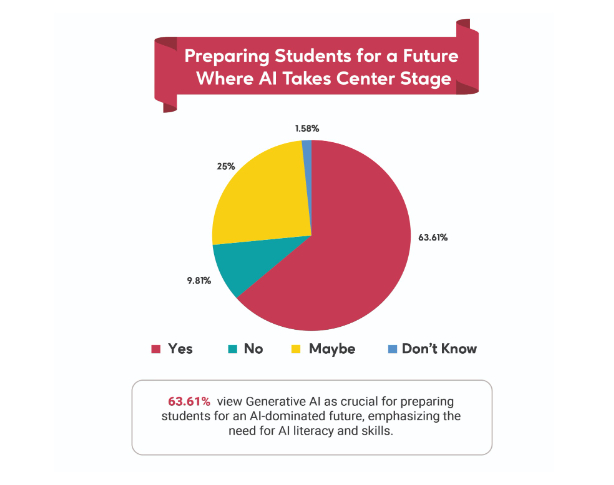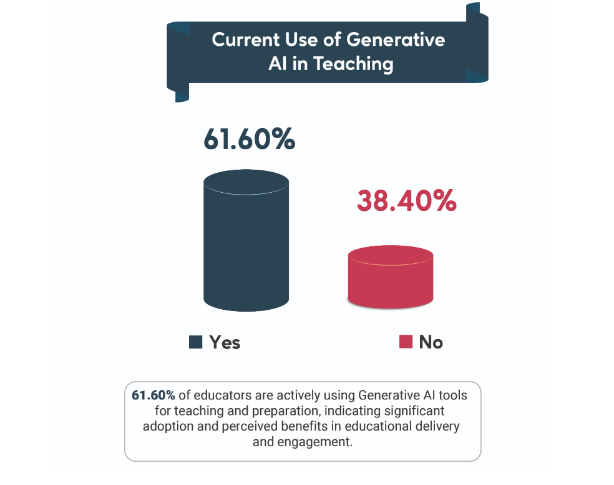Every day in education, technology has been a source of change. One of the breakthroughs is Generative Artificial Intelligence (Generative AI) – a technology with great potential to revolutionise pedagogy. The blog presents the core elements of successful Generative AI implementation in the classroom, analyses its long-term effect on student engagement and learning performance, and evaluates how much time class preparation will reduce due to Generative AI usage by students.
Important Factors for Effective Generative AI Implementation in the Classroom
Generative AI implementation in the classroom requires careful consideration to attain successful results. A vital element is intense teacher training. Educators should be provided with the necessary skills and knowledge to integrate this technology into their teaching methods. Workshops, training sessions and continuous professional development activities are integral in equipping teachers with the tools of Generative AI for enhanced pedagogical goals.
Another essential element is whether or not Generative AI tools are compatible with the curriculum. These tools should seamlessly align with the learning objectives and instructional strategies without being a complete substitute for traditional practices. This aims to enrich the learning environment where students and teachers work in unison with AI to provide a unique solution depending on their challenges.
Further, providing accessibility to all students is crucial. The inclusivity of design should include a broad spectrum of learning styles and abilities when incorporating generative AI tools. This may consist of customising options, adaptive elements and user-friendly interfaces tailored to the diverse requirements of a classroom.
Long-Term Effect of Generative AI on Student Participation and Learning
Generative Artificial Intelligence can transform student engagement and learning in a new way. Generative AI-personalised content and adaptability to individual learning patterns support the needs of every student separately. This personalised way of learning enriches the connection with new material and makes learning maternally interesting, which makes studying more relaxed.
In addition, Generative AI can offer continuous evaluation, allowing the students to gauge their performance as they continue learning. This increases motivation and makes students accountable for their learning process. Personalised support and training based on strengths and weaknesses enhance the learning process because it is more effective and efficient.

A substantial proportion feels that Generative AI will enhance learning to some degree. This perspective suggests that while AI has the potential to positively impact education, its effectiveness may be dependent on various factors such as implementation strategy, technological integration, and the nature of the subject matter.
Additionally, Generative AI can promote shared learning. Using such collected information about group dynamics, the technology can determine the best team configurations and assigned roles; it may also recommend collaborative projects designed explicitly for maximised learning outcomes. This collaborative nature not only helps the learners to adjust when faced with real-life events but also enables them to develop crucial soft skills.
Class Preparation Time and Generative AI
One of the significant problems that educators need to improve is how they prepare for class, which takes up a lot of time. This is where generative AI takes over some aspects of this process. AI-powered tools can help create lesson plans, form quizzes, and sometimes even recommend additional resources, thus reducing the load on teachers.
Automation of routine processes allowed teachers to focus on activities that need individual creativity and analysis. This change in emphasis gives educators opportunities to nurse in a more diverse and interactive classroom setting. This outcome is an effective and more enjoyable dynamic between teachers and students.
Nevertheless, it is critical to find a middle ground. Though Generative AI may help to organise some parts of teaching, it should never be taken as a proper substitute for the human factor. Educators should always stay at the decision-making centre and use AI only as a bridging tool to improve their potential instead of overtaking them.
The Impact of Generative AI on Institutional Learning Environments
The incorporation of Generative AI in the process of teaching methods transcends beyond a single classroom; it defines an institutional learning environment. Such adoption of this technology will see institutions creating a dynamic and innovative learning environment.

With the help of generative AI, it is possible to promote an intelligent campus where decisions at different levels are based on data-driven insights. Institutions can use AI to optimise resource allocation, predict student needs and improve the overall quality of education in terms of efficiency.
Additionally, implementing Generative AI augments institutions to keep up with changes in the marketplace. Educational institutions prepare their graduates for success in today's workplace by exposing them to leading-edge technology and creating a techno-friendly study environment.
Finally, the impact of Generative AI on pedagogy is manifold. Teacher training, curriculum alignment, and accessibility are considered for successful implementation. The long-term effects are favourable as personalised, collaborative and feedback-based environments will become the norm. With the help of Generative AI, class preparations are made more accessible, which allows teachers to focus on more important elements such as critical thinking and creativity. For instance, at the institutional level, AI integration leads to a futuristic learning environment that provides learners with the right skills that will allow them to navigate through an unpredictable world. Generative AI represents an essential ally in the ongoing evolution of education, guiding us towards more innovative and efficient practices.
